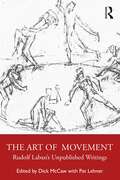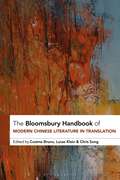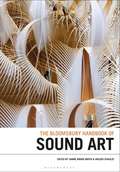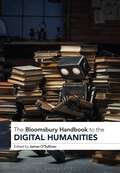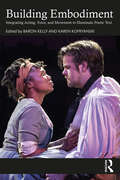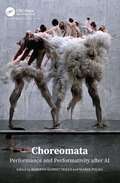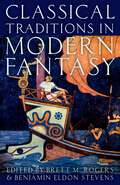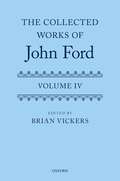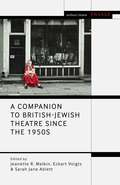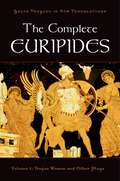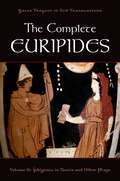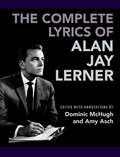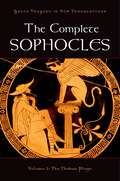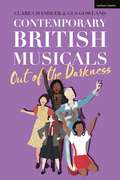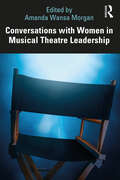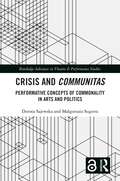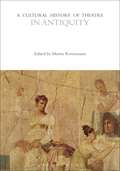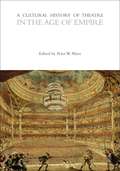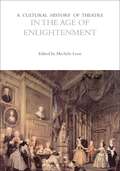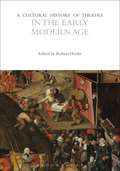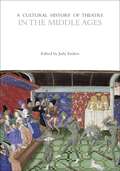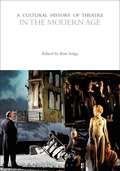- Table View
- List View
The Art of Movement: Rudolf Laban’s Unpublished Writings
The Art of Movement: Rudolf Laban’s Unpublished Writings offers new perspectives on the thinking and practice of Rudolf Laban – one of the pioneers of modern European dance and movement analysis. A wealth of Laban’s previously untranslated writings broadens our understanding of his work through new perspectives on his thinking and practice. Alongside these key primary sources, interviews with Laban’s family and colleagues and editorial commentaries shed new light on the significance of his life and career. Laban’s own texts also offer further elaboration of the key themes of his work – eukinetics, choreutics, lay dance, pedagogy and dance notation. This essential companion to The Laban Sourcebook is an ideal resource for any students or scholars of modern dance, dance studies, dance history and movement analysis looking for a deeper understanding of this seminal figure in their field.
The Bloomsbury Handbook of Modern Chinese Literature in Translation (Bloomsbury Handbooks)
Offering the first systematic overview of modern and contemporary Chinese literature from a translation studies perspective, this handbook provides students, researchers and teachers with a context in which to read and appreciate the effects of linguistic and cultural transfer in Chinese literary works. Translation matters. It always has, of course, but more so when we want to reap the benefits of intercultural communication. In many universities Chinese literature in English translation is taught as if it had been written in English. As a result, students submit what they read to their own cultural expectations; they do not read in translation and do not attend to the protocols of knowing, engagements and contestations that bind literature and society to each other. The Bloomsbury Handbook of Modern Chinese Literature in Translation squarely addresses this pedagogical lack. Organised in a tripartite structure around considerations of textual, social, and large-scale spatial and historical circumstances, its thirty plus essays each deal with a theme of translation studies, as emerged from the translation of one or more Chinese literary works. In doing so, it offers new tools for reading and appreciating modern and contemporary Chinese literature in the global context of its translation, offering in-depth studies about eminent Chinese authors and their literary masterpieces in translation. The first of its kind, this book is essential reading for anyone studying or researching Chinese literature in translation.
The Bloomsbury Handbook of Sound Art (Bloomsbury Handbooks)
The Bloomsbury Handbook of Sound Art explores and delineates what Sound Art is in the 21st century. Sound artworks today embody the contemporary and transcultural trends towards the post-apocalyptic, a wide sensorial spectrum of sonic imaginaries as well as the decolonization and deinstitutionalization around the making of sound. Within the areas of musicology, art history, and, later, sound studies, Sound Art has evolved at least since the 1980s into a turbulant field of academic critique and aesthetic analysis. Summoning artists, researchers, curators, and critics, this volume takes note of and reflects the most recent shifts and drifts in Sound Art--rooted in sonic histories and implying future trajectories.
The Bloomsbury Handbook to the Digital Humanities (Bloomsbury Handbooks)
The Bloomsbury Handbook to the Digital Humanities reconsiders key debates, methods, possibilities, and failings from across the digital humanities, offering a timely interrogation of the present and future of the arts and humanities in the digital age. Comprising 43 essays from some of the field's leading scholars and practitioners, this comprehensive collection examines, among its many subjects, the emergence and ongoing development of DH, postcolonial digital humanities, feminist digital humanities, race and DH, multilingual digital humanities, media studies as DH, the failings of DH, critical digital humanities, the future of text encoding, cultural analytics, natural language processing, open access and digital publishing, digital cultural heritage, archiving and editing, sustainability, DH pedagogy, labour, artificial intelligence, the cultural economy, and the role of the digital humanities in climate change. The Bloomsbury Handbook to the Digital Humanities:Surveys key contemporary debates within DH, focusing on pressing issues of perspective, methodology, access, capacity, and sustainability.Reconsiders and reimagines the past, present, and future of the digital humanities.Features an intuitive structure which divides topics across five sections: “Perspectives & Polemics”, “Methods, Tools & Techniques”, “Public Digital Humanities”, “Institutional Contexts”, and “DH Futures”.Comprehensive in scope and accessibility written, this book is essential reading for students, scholars, and practitioners working across the digital humanities and wider arts and humanities.Featuring contributions from pre-eminent scholars and radical thinkers both established and emerging, The Bloomsbury Handbook to the Digital Humanities should long serve as a roadmap through the myriad formulations, methodologies, opportunities, and limitations of DH. Comprehensive in its scope, pithy in style yet forensic in its scholarship, this book is essential reading for students, scholars, and practitioners working across the digital humanities, whatever DH might be, and whatever DH might become.
Building Embodiment: Integrating Acting, Voice, and Movement to Illuminate Poetic Text
Building Embodiment: Integrating Acting, Voice, and Movement to Illuminate Poetic Text offers a collection of strategic and practical approaches to understanding, analyzing, and embodying a range of heightened text styles, including Greek tragedy, Shakespeare, and Restoration/comedy of manners. These essays offer insights from celebrated teachers across the disciplines of acting, voice, and movement and are designed to help actors and instructors find deeper vocal and physical connections to poetic text. Although each dramatic genre offers a unique set of challenges, Building Embodiment highlights instances where techniques can be integrated, revealing how the synthesis of body, brain, and word results in a fuller sense of character experiencing for both the actor and the audience. This book bridges the gap between academic and professional application and invites the student and professional actor into a richer experience of character and story.
Charles Macklin and the Theatres of London (Eighteenth-Century Worlds #11)
Charles Macklin (1699?–1797) was one of the most important figures in the eighteenth-century theatre. Born in Ireland, he began acting in London in around 1725 and gave his final performance in 1789 – no other actor can claim to have acted across seven decades of the century, from the reign of George I to the Regency Crisis of 1788. He is credited alongside Garrick with the development of the natural school of acting and gave a famous performance of Shylock that gave George II nightmares. As a dramatist, he wrote one of the great comic pieces of the mid-century (Love à la Mode, 1759), as well as the only play of the century to be twice refused a performance licence (The Man of the World, 1781). He opened an experimental coffeehouse in Covent Garden, he advocated energetically for actors’ rights and copyright reform for dramatists, and he successfully sued theatre rioters. In short, he had an astonishingly varied career. With essays by leading experts on eighteenth-century culture, this volume provides a sustained critical examination of his career, illuminating many aspects of eighteenth-century theatrical culture and of the European Enlightenment, and explores the scholarly benefit – and thrill – of restaging Macklin’s work in the twenty-first century.
Choreomata: Performance and Performativity after AI
Is artificial intelligence (AI) becoming more and more expressive, or is human thought adopting more and more structures from computation? What does it mean to perform oneself through AI, or to construct one’s subjectivity through AI? How does AI continue to complicate what it means to have a body? Has the golden age of AI, especially with regards to creative applications, already ended? Choreomata: Performance and Performativity after AI is a book about performance and performativity, but more specifically, it is a book about the performance of artificiality and the performance of intelligence. Both humans and human-designed computational forces are thoroughly engaged in an entangled, mutual performance of AI. Choreomata spins up a latticework of interdisciplinary thought, pairing theoretical inquiry from philosophy, information theory, and computer science with practical case studies from visual art, dance, music, and social theory. Through cross-disciplinary proportions and a diverse roster of contributors, this book contains insights for computer scientists, social scientists, industry professionals, artists, and beyond.
Classical Traditions in Modern Fantasy
Classical Traditions in Modern Fantasy is the first collection of essays in English focusing on how fantasy draws deeply on ancient Greek and Roman mythology, philosophy, literature, history, art, and cult practice. Presenting fifteen all-new essays intended for both scholars and other readers of fantasy, this volume explores many of the most significant examples of the modern genre-including the works of H. P. Lovecraft, J. R. R. Tolkien's The Hobbit, C. S. Lewis's Chronicles of Narnia, J. K. Rowling's Harry Potter series, George R. R. Martin's Game of Thrones series, and more-in relation to important ancient texts such as Aeschylus' Oresteia, Aristotle's Poetics, Virgil's Aeneid, and Apuleius' The Golden Ass. These varied studies raise fascinating questions about genre, literary and artistic histories, and the suspension of disbelief required not only of readers of fantasy but also of students of antiquity. Ranging from harpies to hobbits, from Cyclopes to Cthulhu, and all manner of monster and myth in-between, this comparative study of Classics and fantasy reveals deep similarities between ancient and modern ways of imagining the world. Although antiquity and the present day differ in many ways, at its base, ancient literature resonates deeply with modern fantasy's image of worlds in flux and bodies in motion.
The Collected Works of John Ford: Volume IV (Oxford English Texts)
Volume IV of the Collected Works of John Ford is the first of two volumes in the series to contain his sole-authored plays. It contains three of his most celebrated plays: 'Tis Pity She's a Whore (1622), The Lovers' Melancholy (1628), and The Broken Heart (1629), as well as the less well-known The Queen (1629). The volume opens with a general introduction to Ford's work as a sole author by Sir Brian Vickers and each play is given a detailed introduction emphasizing Ford's linguistic creativity and his effective use of the indoor private theatres. Authoritative old-spelling texts, freshly edited from the original quartos with full textual collations, are accompanied by a full commentary on all aspects of the plays, from archaic or obsolete words to classical allusions and historical references to people, places, and social customs.
Colonial-Era Caribbean Theatre: Issues in Research, Writing and Methodology
Cutting across academic boundaries, this volume brings together scholars from different disciplines who have explored together the richness and complexity of colonial-era Caribbean theatre. The volume offers a series of original essays that showcase individual expertise in light of broader group discussions. Asking how we can research effectively and write responsibly about colonial-era Caribbean theatre today, our primary concern is methodology. Key questions are examined via new research into individual case studies on topics ranging from Cuban blackface, commedia dell’arte in Suriname and Jamaican oratorio to travelling performers and the influence of the military and of enslaved people on theatre in Saint-Domingue. Specifically, we ask what particular methodological challenges we as scholars of colonial-era Caribbean theatre face and what methodological solutions we can find to meet those challenges. Areas addressed include our linguistic limitations in the face of Caribbean multilingualism; issues raised by national, geographical or imperial approaches to the field; the vexed relationship between metropole and colony; and, crucially, gaps in the archive. We also ask what implications our findings have for theatre performance today – a question that has led to the creation of a new work set in a colonial theatre and outlined in the volume’s concluding chapter.
Comedy and Crisis: Pieter Langendijk, the Dutch, and the Speculative Bubbles of 1720 (Eighteenth-Century Worlds #9)
Comedy and Crisis contains the first ever scholarly English translation of Pieter Langendijk’s Quincampoix, or the Wind Traders [Quincampoix of de Windhandelaars], and Harlequin Stock-Jobber [Arlequin Actionist]. The first play is a full-length satirical comedy, and the second is a short, comic harlequinade; both were written in Dutch in response to the speculative financial crisis or bubble of 1720 and were performed in Amsterdam in the fall of 1720, as the bubble in the Netherlands was bursting. Comedy and Crisis also contains our translation of the extensive apparatus prepared by C.H.P. Meijer (Introduction and notes) for his 1892 edition of these plays. The current editors have updated the footnotes and added six new critical essays by contemporary literary and historical scholars that contextualize the two plays historically and culturally. The book includes an extensive bibliography and index. The materials assembled in Comedy and Crisis are a rich resource for cultural, historical, and literary students of the history of finance and of eighteenth-century studies.
A Companion to British-Jewish Theatre Since the 1950s (Methuen Drama Engage)
The first of its kind, this companion to British-Jewish theatre brings a neglected dimension in the work of many prominent British theatre-makers to the fore. Its structure reflects the historical development of British-Jewish theatre from the 1950s onwards, beginning with an analysis of the first generation of writers that now forms the core of post-war British drama (including Tom Stoppard, Harold Pinter and Arnold Wesker) and moving on to significant thematic force-fields and faultlines such as the Holocaust, antisemitism and Israel/Palestine. The book also covers the new generation of British-Jewish playwrights, with a special emphasis on the contribution of women writers and the role of particular theatres in the development of British-Jewish theatre, as well as TV drama. Included in the book are fascinating interviews with a set of significant theatre practitioners working today, including Ryan Craig, Patrick Marber, John Nathan, Julia Pascal and Nicholas Hytner. The companion addresses, not only aesthetic and ideological concerns, but also recent transformations with regard to institutional contexts and frameworks of cultural policies.
The Complete Euripides: Volume I: Trojan Women and Other Plays (Greek Tragedy in New Translations)
Based on the conviction that only translators who write poetry themselves can best re-create the celebrated and timeless tragedies of Aeschylus, Sophocles, and Euripides, the Greek Tragedy in New Translations series offers new translations that go beyond the literal meaning of the Greek in order to evoke the poetry of the originals. The tragedies collected here were originally available as single volumes. This new collection retains the informative introductions and explanatory notes of the original editions, with Greek line numbers and a single combined glossary added for easy reference. This volume collects Euripides' Andromache, a play that challenges the concept of tragic character and transforms expectations of tragic structure; Hecuba, a powerful story of the unjustifiable sacrifice of Hecuba's daughter and the consequent destruction of Hecuba's character; Trojan Women, a particularly intense account of human suffering and uncertainty; and Rhesos, the story of a futile quest for knowledge.
The Complete Euripides: Volume II: Iphigenia in Tauris and Other Plays (Greek Tragedy in New Translations)
Based on the conviction that only translators who write poetry themselves can best re-create the celebrated and timeless tragedies of Aeschylus, Sophocles, and Euripides, the Greek Tragedy in New Translations series offers new translations that go beyond the literal meaning of the Greek in order to evoke the poetry of the originals. The tragedies collected here were originally available as single volumes. This new collection retains the informative introductions and explanatory notes of the original editions, with Greek line numbers and a single combined glossary added for easy reference. The volume collects Euripides' Electra, an exciting story of vengence that counterposes suspense and horror with comic realism; Orestes, the tragedy of a young man who kills his mother to avenge her murder of his father; Iphigenia in Tauris, a delicately written and beautifully contrived Euripidean "romance"; and Iphigenia at Aulis, a compelling look at the devastating consequence of "man's inhumanity to man."
The Complete Lyrics of Alan Jay Lerner
Alan Jay Lerner wrote the lyrics for some of the most beloved musicals in Broadway and Hollywood history. Most notably, with composer Frederick Loewe he created enduring hits such as My Fair Lady, Gigi, Camelot, and Brigadoon. In The Complete Lyrics of Alan Jay Lerner, editors and annotators Dominic McHugh and Amy Asch bring all of Lerner's lyrics together for the first time, including numerous draft or alternate versions and songs cut from the shows. Compiled from dozens of archival collections, this invaluable resource and authoritative reference includes both Lerner's classic works and numerous discoveries, including his unproduced MGM movie Huckleberry Finn, selections from his college musicals, and lyrics from three different versions of Paint Your Wagon. This collection also includes extensive material from Lerner's two most ambitious musicals: Love Life, to music by Kurt Weill, and 1600 Pennsylvania Avenue, which Lerner wrote with Leonard Bernstein.
The Complete Sophocles: Volume I: The Theban Plays (Greek Tragedy in New Translations)
Based on the conviction that only translators who write poetry themselves can best re-create the celebrated and timeless tragedies of Aeschylus, Sophocles, and Euripides, the Greek Tragedy in New Translations series offers new translations that go beyond the literal meaning of the Greek in order to evoke the poetry of the originals. The tragedies collected here were originally available as single volumes. This new collection retains the informative introductions and explanatory notes of the original editions, with Greek line numbers and a single combined glossary added for easy reference. This volume collects for the first time three of Sophocles most moving tragedies, all set in mythical Thebes: Oedipus the King, perhaps the most powerful of all Greek tragedies; Oedipus at Colonus, a story that reveals the reversals and paradoxes that define moral life; and Antigone, a touchstone of thinking about human conflict and human tragedy, the role of the divine in human life, and the degree to which men and women are the creators of their own destiny.
Contemporary British Musicals: ‘Out of the Darkness’
The shortest runs can have the longest legacies: for too long, scholarship surrounding British musical theatre has coalesced around the biggest names, ignoring important works that have not had the critical engagement they deserve. Through academic interrogation and industry insight, this unique collection of essays recognizes these works, shining a light on their creative achievements and legacies. With each chapter focusing on a different significant musical, a selection of shows spanning 2010s are analysed and the development and evolution of the genre is explored. Touching on key, hit shows such as SIX, Matilda, Everybody's Talking About Jamie, The Grinning Man and Bend it Like Beckham, each chapter discusses different theatrical elements, from dramaturgy and musicology to reception, and also includes an interview with a practitioner related to each musical, providing in-depth understanding and invaluable practical and industry knowledge. Identifying the intersectionality between industry insight and academic analysis, Contemporary British Musicals: 'Out of the Darkness' challenges the narrative that the British musical is dead : creating a new historiography of the British musical that celebrates the work being created, while providing a manifesto for the future.
Conversations with Women in Musical Theatre Leadership
Most writers, composers, librettists, and music directors who make their careers in musical theatre do so without specific training or clear pathways to progress through the industry. Conversations with Women in Musical Theatre Leadership addresses that absence by drawing on the experiences of these women to show the many and varied routes to successful careers on, off, and beyond Broadway. Conversations with Women in Musical Theatre Leadership features 15 interviews with Broadway-level musical theatre music directors, directors, writers, composers, lyricists, stage managers, orchestrators, music arrangers, and other women in positions of leadership. Built around extensive interviews with women at the top of their careers in the creative and leadership spheres of musical theatre, these first-hand accounts offer insight into the jobs themselves, the skills that they require, and how those skills can be developed. Any students of musical theatre and stagecraft, no matter what level and in what setting from professional training to university and conservatory study, will find this a valuable asset.
Crisis and Communitas: Performative Concepts of Commonality in Arts and Politics (Routledge Advances in Theatre & Performance Studies)
This book is a critical, transdisciplinary examination of a broad range of philosophical ideas, theoretical concepts, and artistic projects of community in the 20th and 21st century in the context of global/local social and political changes. This volume opens new vitas by focusing on carefully selected instances of multipronged crises in which existing concepts of commonality are questioned, reformulated, or even speculatively designed with a (better) future in view. As many authors of this volume argue, in the face of today’s unprecedented global ecological and economic challenges speculative design is of utmost importance as it can foster alternative, unthought-of forms of connectivity that go far beyond progressivist narratives of nation, corporation, and nuclear family. Focusing on the situations of upheaval, both historical and fabulated, the collection not only examines how multipronged crises trigger antagonisms between egalitarian forms of communitas and the normative concept of the nation (and other normative forms of communities) as a community that separates and excludes. It also looks closely at philosophical and artistic projects that strive to go beyond the dichotomies and typically extrapolated utopias, envisaging new political economies, ways of living and alternative relational structures. It will be of great interest to students and scholars in performance studies, cultural studies, political studies, media studies, postcolonial and decolonial studies, critical anthropology.
A Cultural History of Theatre in Antiquity (The Cultural Histories Series)
Theatre was at the very heart of culture in Graeco-Roman civilizations and its influence permeated across social and class boundaries. The theatrical genres of tragedy, comedy, satyr play, mime and pantomime operate in Antiquity alongside the conception of theatre as both an entertainment for the masses and a vehicle for intellectual, political and artistic expression. Drawing together contributions from scholars in Classics and Theatre Studies, this volume uniquely examines the Greek and Roman cultural spheres in conjunction with one another rather than in isolation. Each chapter takes a different theme as its focus: institutional frameworks; social functions; sexuality and gender; the environment of theatre; circulation; interpretations; communities of production; repertoire and genres; technologies of performance; and knowledge transmission.
A Cultural History of Theatre in the Age of Empire (The Cultural Histories Series)
The 19th century ushered in an unprecedented boom in technology, the unification of European nations, the building of global empires and stabilization of the middle classes. The theatre of the era reflected these significant developments as well as helped to catalyse them. Populist theatre and purposebuilt playhouses flourished in the ever-growing urban and cosmopolitan centres of Europe and in expanding global networks. This volume provides a comprehensive and interdisciplinary overview of the cultural history of theatre from 1800 to 1920. Highly illustrated with 51 images, the ten chapters each take a different theme as their focus: institutional frameworks; social functions; sexuality and gender; the environment of theatre; circulation; interpretations; communities of production; repertoire and genres; technologies of performance; and knowledge transmission.
A Cultural History of Theatre in the Age of Enlightenment (The Cultural Histories Series)
French philosopher Jean-Jacques Rousseau wrote, 'the general effect of the theatre is to strengthen the national character to augment the national inclinations, and to give a new energy to all the passions'. During the Enlightenment, the advancement of radical ideas along with the emergence of the bourgeois class contributed to a renewed interest in theatre's efficacy, informed by philosophy yet on behalf of politics. While the 18th century saw a growing desire to define the unique and specific features of a nation's drama, and audiences demanded more realistic portrayals of humanity, theatre is also implicated in this age of revolutions. A Cultural History of Theatre in the Age of Enlightenment examines these intersections, informed by the writings of key 18th-century philosophers. Richly illustrated with 45 images, the ten chapters each take a different theme as their focus: institutional frameworks; social functions; sexuality and gender; the environment of theatre; circulation; interpretations; communities of production; repertoire and genres; technologies of performance; and knowledge transmission.
A Cultural History of Theatre in the Early Modern Age (The Cultural Histories Series)
For both producers and consumers of theatre in the early modern era, art was viewed as a social rather than an individual activity. Emerging in the context of new capitalistic modes of production, the birth of the nation state and the rise of absolute monarchies, theatre also proved a highly mobile medium across geolinguistic boundaries. This volume provides a comprehensive and interdisciplinary overview of the cultural history of theatre from 1400 to 1650, and examines the socioeconomically heterodox nature of theatre and performance during this period. Highly illustrated with 48 images, the ten chapters each take a different theme as their focus: institutional frameworks; social functions; sexuality and gender; the environment of theatre; circulation; interpretations; communities of production; repertoire and genres; technologies of performance; and knowledge transmission.
A Cultural History of Theatre in the Middle Ages (The Cultural Histories Series)
Historically and broadly defined as the period between the fall of the Roman Empire and the rise of the Renaissance, the Middle Ages encompass a millennium of cultural conflicts and developments. A large body of mystery, passion, miracle and morality plays cohabited with song, dance, farces and other public spectacles, frequently sharing ecclesiastical and secular inspiration. A Cultural History of Theatre in the Middle Ages provides a comprehensive and interdisciplinary overview of the cultural history of theatre between 500 and 1500, and imaginatively pieces together the puzzle of medieval theatre by foregrounding the study of performance. Each of the ten chapters of this richly illustrated volume takes a different theme as its focus: institutional frameworks; social functions; sexuality and gender; the environment of theatre; circulation; interpretations; communities of production; repertoire and genres; technologies of performance; and knowledge transmission.
A Cultural History of Theatre in the Modern Age (The Cultural Histories Series)
To call something modern is to assert something fundamental about the social, cultural, economic and technical sophistication of that thing, over and against what has come before. A Cultural History of Theatre in the Modern Age provides an interdisciplinary overview of theatre and performance in their social and material contexts from the late 19th century through the early 2000s, emphasizing key developments and trends that both exemplify and trouble the various meanings of the term 'modern', and the identity of modernist theatre and performance. Highly illustrated with 40 images, the ten chapters each take a different theme as their focus: institutional frameworks; social functions; sexuality and gender; the environment of theatre; circulation; interpretations; communities of production; repertoire and genres; technologies of performance; and knowledge transmission.
